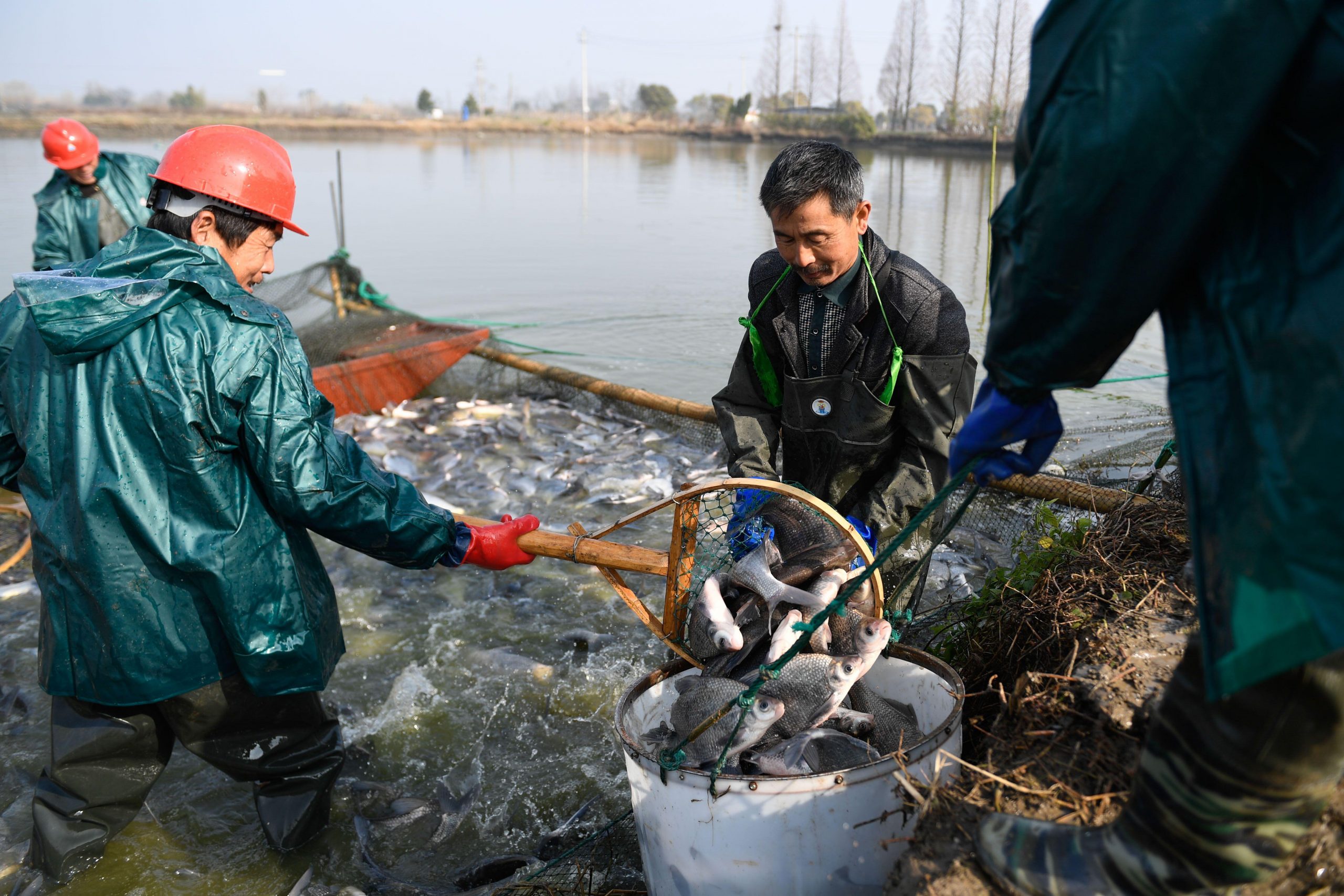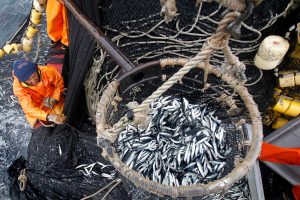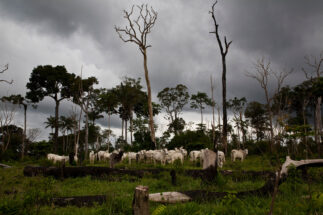The fishing and aquaculture industry is important for China’s economy and the livelihoods of the more than 17 million people who work in it.
It is becoming more apparent that overfishing and poorly managed aquaculture is causing pollution, biodiversity loss and habitat destruction, threatening ecosystems and the industry’s future.
Fishing and aquaculture are expected to provide 69 million tonnes of seafood for China between 2021 and 2025. A transition to sustainability is key to ensuring the industry’s resilience and protecting the environment. In fact, this is now a national strategy, visible in the central government plan for the industry during the 14th Five Year Plan period (2021–2025), which stresses the importance of sustainability.
The regulation-heavy approach to sustainability
Management of fishing and aquaculture currently relies on government oversight. Gradual improvements have been made over recent years by limiting the number of boats and the size of their engines, and placing caps on overall catch size. Technical measures, such as closed seasons and restrictions on fishing gear, have also been put in place, along with aquaculture permitting and capacity planning.
However, the top-down approach to tackling problems means regulators predominantly shoulder the challenging burden of managing the different fish populations, vessels, fishing gear, aquaculture techniques, inputs and resulting pollution.
The sector is mainly made up of small operators and a few big firms. The millions of people employed in it along the length of China’s coast use a wide range of techniques to produce a diverse catch. The measures and regulations that the authorities employ need input from scientific research. The implementation of command and control is further complicated and made more costly by the decentralised and unstandardised ways that fish are produced. Regulation should not be the only approach.
In addition to command and control regulations, the transformation of the sector is also being helped by changes to subsidies (for example, a switch from fuel subsidies to fishery stewardship subsidies), technical innovations, and construction of fishing industry zones and other infrastructure.
How could finance help manage fishing?
Besides relying on government regulations, the financial sector can play an important role as it is skilled in resource allocation and risk management, meaning it could support the sustainable development of the fishing and aquaculture industry.
In a recent series of reports – “Financing Sustainable Seafood” – the International Institute of Green Finance (IIGF) and the WWF Beijing Office presented joint research into the link between seafood finance and sustainable development.
Financial institutions, which provide loans and insurance products, would reduce their own risks by driving a sustainable transition in the fishing and aquaculture industry. This is because harm to the environment caused by the industry equates to environment-related financial risks for financial institutions. The loss of fishery resources, as well as algal or jellyfish blooms, and fish diseases, are physical risks that directly threaten the industry.
Financial institutions also face transition risks as China tightens regulation of fishing and aquaculture. These include longer closed seasons, quotas, tougher standards for aquaculture effluent, and more investment in law enforcement, such as the fishery authorities’ “Bright Sword” campaigns. Fishers and fish farmers must invest to comply with regulations, or face fines or closure. Meanwhile, food safety and environmental demands are increasing at home and abroad, adding to the risk of products becoming uncompetitive or facing barriers to market entry.
Financial institutions need to identify, assess, monitor and control such risks or they could result in a borrower failing to make repayments or an insurance policyholder claiming more than expected. Doing so would help avoid losses while also guiding the fishing and aquaculture industry towards sustainability.
Pathways to sustainability
Financial institutions can promote sustainable fishing and aquaculture practices by integrating sustainability standards into their processes.
Institutions should make access to lending and insurance contracts conditional on environmental performance. Unsustainable production practices often imply lower operating costs, meaning firms that employ them are likely to perform better financially and more easily access loans and other financial services. Screening clients based on environmental performances at an early stage helps to prevent the phenomenon of “bad money driving out the good”.
Institutions should also better supply the fishing and aquaculture industry’s demands for green finance, funding and insurance for sustainable production (specifically for sustainable fishing activity).
The contribution of financial institutions to the sustainable transition and risk management of China’s fishing and aquaculture industry is limited. The focus on financial performance and operational risks mean there is minimal incorporation of sustainability as a concept in their provision of financial services. Environmental impacts are given little if any consideration. Sustainability clauses are not regularly included in loans and insurance contracts. Few insurance and loan products are designed for sustainable production practices. And there is no system in place for managing environment-related financial risks.
This is primarily due to the nature of the fishing and aquaculture industry. Producers are small and widely distributed. They deploy a range of production methods. Information on production and environmental impacts is limited, making it difficult for financial institutions to obtain a comprehensive understanding of the industry. Monitoring production and environmental impact is therefore expensive and increases the costs of risk management.
The contribution of financial institutions to the sector is also stymied by a lack of general policy guidance promoting sustainability and green finance tools. The inherent operational risks in the fishing sector make financial institutions reluctant to provide services; instead they need to be forced to by government policy. General green finance taxonomies, which are designed to help financial institutions identify suitable projects, lack compatibility with the sector. The Green Industry Guidance Catalogue and the Catalogue of Projects Supported by Green Bonds, which are supposed to guide green finance and green bond issuance, cover only more modern fishing activities and are therefore of very limited applicability to the sector.
Stakeholder involvement
If finance is to play its proper role, while managing relevant financial risks, a collective effort by a range of stakeholders is needed.
The natural characteristics of the fishing and aquaculture sector will need to be addressed to take down its financing barriers. There should first be organisation and aggregation: cooperatives, industry associations and NGOs should bring seafood producers together to permit mobilisation at scale.
Second, information availability and transparency should be addressed. New technology can increase the accessibility of basic information about the sector, such as the location, area and owner of an aquaculture pond, and information on processes, such as when vessels depart from ports and their catches, or the timing, frequency and quantity of feeding in aquaculture.
For example, the ChinaBlue Sustainability Institute works with local fishing communities in Hainan province, as well as with industry associations and financial institutions, to aggregate and organise the otherwise decentralised and scattered producers, and make information more widely available. By working with NGOs like ChinaBlue, financial institutions can communicate with stakeholders and improve their knowledge of the sector. They can also invest in training and recruiting personnel with interdisciplinary experience and improve their knowledge about the financial needs of the sector.
Government policy is a key driver of the financial services provided to the sector. Guidance and appropriate policy tools are needed to put financial services on a sustainable path. That includes sending clear policy signals to encourage financial institutions to promote sustainability.
The agricultural and financial regulators should also produce policy tools, such as specialised taxonomies for the fishing and aquaculture sector or lists of projects and firms to avoid supporting. Some international organisations have carried out preliminary research. The UN Environment Programme’s “Finance Initiative” (UNEP FI) reports series on the blue economy includes an overview of activities to exclude from financing, based on factors such as pollution, fishing method and labour conditions. The International Finance Corporation’s (IFC) Guidelines for Blue Finance present key factors that financial institutions should consider when selecting recipients for their services. The standards proposed are mainly based on certification schemes such as that operated by the Marine Stewardship Council (MSC). The authorities can also encourage sustainable financial products and services by subsidising preferential interest rates and insurance premiums.
Finally, financial institutions need to build environmental considerations into their decision-making processes by developing financial products that promote sustainable development and manage the financial risks associated with environmental performance. Internal management adjustments could include setting up departments to assess environmental performance and manage environment-related financial risk in the sector.
In financial services provision, clauses on environmental impacts should be included in credit and insurance agreements, with long-term monitoring to ensure sustainability and effective risk management.
At the product level, green insurance and loans for the sector require innovation and cooperation with NGOs, firms and the government. For example, ChinaBlue has worked with local marketing associations and insurance providers to create an insurance product specifically for tilapia as well as to embed sustainability standards into other financial products and services.








